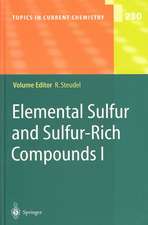Biomass and Green Chemistry: Building a Renewable Pathway
Editat de Sílvio Vaz Jr.en Limba Engleză Hardback – 27 noi 2017
The need to develop renewable feedstock for the chemical industry to replace oil has been identified as a major strategic challenge for the 21st century. In this context, the use of different types of vegetable biomass – starch, lignocellulosic, oleaginous, saccharide and algae – can be seenas a viable alternative to the use of non-renewable, more expensive raw materials. Furthermore, it offers a model for adding economic value to the agro industrial chains such as soybean, sugarcane, corn and forests, among others. This will in turn contribute to the sustainability of a wide range of chemicals, mainly organics and their transformation processes, which are widely used by modern society.
| Toate formatele și edițiile | Preț | Express |
|---|---|---|
| Paperback (1) | 579.68 lei 39-44 zile | |
| Springer International Publishing – 9 sep 2018 | 579.68 lei 39-44 zile | |
| Hardback (1) | 949.10 lei 6-8 săpt. | |
| Springer International Publishing – 27 noi 2017 | 949.10 lei 6-8 săpt. |
Preț: 949.10 lei
Preț vechi: 1157.44 lei
-18% Nou
Puncte Express: 1424
Preț estimativ în valută:
181.64€ • 188.02$ • 153.52£
181.64€ • 188.02$ • 153.52£
Carte tipărită la comandă
Livrare economică 06-20 martie
Preluare comenzi: 021 569.72.76
Specificații
ISBN-13: 9783319667355
ISBN-10: 3319667351
Pagini: 260
Ilustrații: X, 252 p. 84 illus., 47 illus. in color.
Dimensiuni: 155 x 235 mm
Greutate: 0.55 kg
Ediția:1st ed. 2018
Editura: Springer International Publishing
Colecția Springer
Locul publicării:Cham, Switzerland
ISBN-10: 3319667351
Pagini: 260
Ilustrații: X, 252 p. 84 illus., 47 illus. in color.
Dimensiuni: 155 x 235 mm
Greutate: 0.55 kg
Ediția:1st ed. 2018
Editura: Springer International Publishing
Colecția Springer
Locul publicării:Cham, Switzerland
Cuprins
Chapter 1. Biomass and the Green Chemistry Principles.- Chapter 2. Saccharide Biomass for Biofuels, Biomaterials and Chemicals.- Chapter 3. Oleaginous Biomass for Biofuels, Biomaterials and Chemicals.- Chapter 4. Starch Biomass for Biofuels, Biomaterials and Chemicals.- Chapter 5. Lignocellulosic Biomass for Energy, Biofuels, Biomaterials, and Chemicals.- Chapter 6. Microalgae for Industrial Purposes.- Chapter 7. Enzymatic Conversion of First and Second Generation Sugars.- Chapter 8. Sustainability of Biomass.
Notă biografică
Prof. Dr. Sílvio Vaz Junior holds a BSc degree in Chemistry, a MSc degree in Physical Chemistry and a PhD degree in Analytical Chemistry from University of São Paulo, Brazil. He was director and partner of two private analytical laboratories related to environmental analysis technologies. Since 2010, he is a research scientist at the state-owned Brazilian Agricultural Research Corporation (Embrapa) working on the development of renewable chemicals from biomass and analytical chemistry applied to bioenergy and biomass chemistry. He is a member of IUPAC and has published articles and books related to renewable chemistry and analytical chemistry.
Textul de pe ultima copertă
This book investigates the main vegetable biomass types, their chemical characteristics and their potential to replace oil as raw material for the chemical industry, according to the principles of green chemistry. Authors from different scientific and technical backgrounds, from industry and academia, give an overview of the state of the art and ongoing developments. Aspects including bioeconomy, biorefineries, renewable chemistry and sustainability are also considered, given their relevance in this context. Furthermore, the book reviews green chemistry principles and their relation to biomass, while also exploring the main processes for converting biomass into bioproducts.
The need to develop renewable feedstock for the chemical industry to replace oil has been identified as a major strategic challenge for the 21st century. In this context, the use of different types of vegetable biomass – starch, lignocellulosic, oleaginous, saccharide and algae – can be seenas a viable alternative to the use of non-renewable, more expensive raw materials. Furthermore, it offers a model for adding economic value to the agro industrial chains such as soybean, sugarcane, corn and forests, among others. This will in turn contribute to the sustainability of a wide range of chemicals, mainly organics and their transformation processes, which are widely used by modern society.
The need to develop renewable feedstock for the chemical industry to replace oil has been identified as a major strategic challenge for the 21st century. In this context, the use of different types of vegetable biomass – starch, lignocellulosic, oleaginous, saccharide and algae – can be seenas a viable alternative to the use of non-renewable, more expensive raw materials. Furthermore, it offers a model for adding economic value to the agro industrial chains such as soybean, sugarcane, corn and forests, among others. This will in turn contribute to the sustainability of a wide range of chemicals, mainly organics and their transformation processes, which are widely used by modern society.
Caracteristici
Provides a concise description of the relevance and uses of biomass in green chemistry, based on the 7th green chemistry principle (use of renewable feedstock) Examines the main approaches to applying green processes for biomass conversion Provides essential information on the global distribution of biomass Explores reactions and physicochemical properties of the main biomass components





















